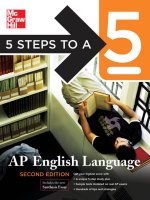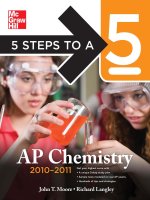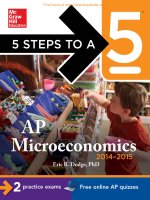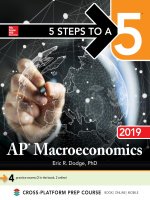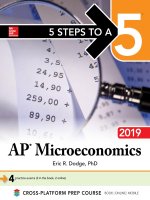5 Steps to a 5_ 500 AP English Literature Questions to Know By Test Day
Bạn đang xem bản rút gọn của tài liệu. Xem và tải ngay bản đầy đủ của tài liệu tại đây (1 MB, 224 trang )
5
™
5 STEPS TO A
500
AP English Literature Questions
to know by test day
Also in the 5 Steps Series:
5 Steps to a 5: AP English Literature
5 Steps to a 5: AP English Literature with CD-ROM
Also in the 500 AP Questions to Know by Test Day series:
5 Steps to a 5: 500 AP Biology Questions to Know by Test Day
5 Steps to a 5: 500 AP English Language Questions to Know by Test Day
5 Steps to a 5: 500 AP Psychology Questions to Know by Test Day
5 Steps to a 5: 500 AP U.S. History Questions to Know by Test Day
5 Steps to a 5: 500 AP World History Questions to Know by Test Day
5
™
5 STEPS TO A
500
AP English Literature Questions
to know by test day
Shveta Verma Miller
New York Chicago San Francisco Lisbon London Madrid Mexico City
Milan New Delhi San Juan Seoul Singapore Sydney Toronto
SHVETA VERMA MILLER has taught English literature and English as a foreign language at the high school and
college level in the United States, England, India, Japan, and China. Prior to that, she taught SAT preparation with
both the Princeton Review and Kaplan. She has a bachelor’s degree in English literature from the University of
California, Berkeley, and a master’s degree in modern literature from the University of London, England.
Copyright © 2011 by The McGraw-Hill Companies, Inc. All rights reserved. Except as permitted under the United
States Copyright Act of 1976, no part of this publication may be reproduced or distributed in any form or by any
means, or stored in a database or retrieval system, without the prior written permission of the publisher.
ISBN: 978-0-07-175411-8
MHID: 0-07-175411-3
The material in this eBook also appears in the print version of this title: ISBN: 978-0-07-175410-1,
MHID: 0-07-175410-5.
All trademarks are trademarks of their respective owners. Rather than put a trademark symbol after every
occurrence of a trademarked name, we use names in an editorial fashion only, and to the benefit of the trademark
owner, with no intention of infringement of the trademark. Where such designations appear in this book, they have
been printed with initial caps.
McGraw-Hill eBooks are available at special quantity discounts to use as premiums and sales promotions, or for use
in corporate training programs. To contact a representative please e-mail us at
Trademarks: McGraw-Hill, the McGraw-Hill Publishing logo, 5 Steps to a 5, and related trade dress are
trademarks or registered trademarks of The McGraw-Hill Companies and/or its affi liates in the United States and other
countries and may not be used without written permission. All other trademarks are the property of their respective
owners. The McGraw-Hill Companies is not associated with any product or vendor mentioned in this book.
TERMS OF USE
This is a copyrighted work and The McGraw-Hill Companies, Inc. (“McGrawHill”) and its licensors reserve all
rights in and to the work. Use of this work is subject to these terms. Except as permitted under the Copyright Act
of 1976 and the right to store and retrieve one copy of the work, you may not decompile, disassemble, reverse
engineer, reproduce, modify, create derivative works based upon, transmit, distribute, disseminate, sell, publish or
sublicense the work or any part of it without McGraw-Hill’s prior consent. You may use the work for your own
noncommercial and personal use; any other use of the work is strictly prohibited. Your right to use the work may be
terminated if you fail to comply with these terms.
THE WORK IS PROVIDED “AS IS.” McGRAW-HILL AND ITS LICENSORS MAKE NO GUARANTEES
OR WARRANTIES AS TO THE ACCURACY, ADEQUACY OR COMPLETENESS OF OR RESULTS
TO BE OBTAINED FROM USING THE WORK, INCLUDING ANY INFORMATION THAT CAN BE
ACCESSED THROUGH THE WORK VIA HYPERLINK OR OTHERWISE, AND EXPRESSLY DISCLAIM ANY
WARRANTY, EXPRESS OR IMPLIED, INCLUDING BUT NOT LIMITED TO IMPLIED WARRANTIES OF
MERCHANTABILITY OR FITNESS FOR A PARTICULAR PURPOSE. McGraw-Hill and its licensors do not
warrant or guarantee that the functions contained in the work will meet your requirements or that its operation
will be uninterrupted or error free. Neither McGraw-Hill nor its licensors shall be liable to you or anyone else
for any inaccuracy, error or omission, regardless of cause, in the work or for any damages resulting therefrom.
McGraw-Hill has no responsibility for the content of any information accessed through the work. Under no
circumstances shall McGraw-Hill and/or its licensors be liable for any indirect, incidental, special, punitive,
consequential or similar damages that result from the use of or inability to use the work, even if any of them has
been advised of the possibility of such damages. This limitation of liability shall apply to any claim or cause
whatsoever whether such claim or cause arises in contract, tort or otherwise.
CONTENTS
Preface vii
Acknowledgments xi
Introduction xiii
Chapter 1 British Poetry 1
Thomas Hardy, “Nobody Comes” 1
Robert Herrick, “To the Virgins, to Make Much of Time” 3
Gerard Manley Hopkins, “God’s Grandeur” 6
Andrew Marvell, “To His Coy Mistress” 9
William Wordsworth, “The world is too much with us” 12
William Butler Yeats, “That the Night Come” 14
Chapter 2 American Poetry 17
Anne Bradstreet, “The Author to Her Book” 17
Emily Dickinson, “Success is counted sweetest . . . ”
T. S. Eliot, “Morning at the Window” 21
Walt Whitman, “O Captain! My Captain!” 23
William Carlos Williams, “Contemporania” 26
19
Chapter 3 World Poetry 29
Kahlil Gibran, “Defeat” 29
Jayadeva, Excerpt from Gita Govinda 31
Rabindranath Tagore, “My Country Awake” and “The Home”
36
Chapter 4 British Fiction 41
Frances Burney, Evelina 41
Joseph Conrad, Heart of Darkness (two passages)
Mary Shelley, Frankenstein (two passages) 50
Jonathan Swift, Gulliver’s Travels 57
Oscar Wilde, The Picture of Dorian Gray 62
43
Chapter 5 American Fiction 67
Kate Chopin, “The Kiss” 67
Nathaniel Hawthorne, The Scarlet Letter (two passages)
Henry James, The Turn of the Screw 76
Sinclair Lewis, Babbitt (two passages) 79
Upton Sinclair, The Jungle 84
70
❮
v
vi ❯ Contents
Chapter 6 World Fiction 89
Miguel de Cervantes, Don Quixote 89
Fyodor Dostoyevsky, Crime and Punishment
Gustave Flaubert, Madame Bovary 95
Hermann Hesse, Siddhartha 98
James Joyce, “The Dead” 101
Franz Kafka, “Metamorphosis” 104
92
Chapter 7 Drama 107
Euripides, Medea (two passages) 107
William Shakespeare, Hamlet and Macbeth
Sophocles, Oedipus the King 118
112
Chapter 8 Expository Prose 123
Charles Darwin, On the Origin of Species 123
Nathaniel Hawthorne, “The Custom House”
(Preface to The Scarlet Letter) 126
Thomas Hobbes, Leviathan 128
Friedrich Nietzsche, Beyond Good and Evil
(Translated by Helen Zimmern) 132
Oscar Wilde, Preface to The Picture of Dorian Gray 135
Zhuangzi 137
Answers
141
PREFACE
Even though students have been enrolling in AP English literature classes and
taking the AP exam for decades, there is a noticeable shortage of multiple-choice
practice and guides in the test prep world. This book is intended to complement a
test-prep curriculum guidebook like McGraw-Hill’s 5 Steps to a 5: AP English Literature, which provides extensive instruction on the content covered in the exam,
including terms, concepts, writing skills, and some multiple-choice practice. 5 Steps
to a 5: 500 AP English Literature Questions to Know by Test Day, however, is unique
and essential in that it provides extensive practice for the multiple-choice section
alone, which comprises 45 percent of the total AP exam score. The book provides
500 practice questions and detailed answer explanations. The questions are comparable to those found on the AP exam, covering similar content and genres.
This book is intended for students to use to prepare for the AP exam independently, in addition to the preparation they may be doing in an actual AP English literature classroom. The book is also useful for teachers to use in their AP
and non-AP classrooms for extra practice and assessment. Students who do not
intend to take the AP exam can still benefit from using this book because the
passages, questions, and answer explanations will train any student of literature
how to develop a subtle and insightful appreciation for and understanding of the
technique, form, style, and purpose of complex literary texts, all skills necessary for
the reading comprehension section of the SAT and other standardized exams in
reading comprehension.
How to Use This Book
The book is divided into eight chapters that are categorized by geographic region
and genre. The multiple-choice questions for the AP exam in English literature
consist mostly of fiction and poetry. Of the fiction passages, most passages are
taken from novels and short stories, while occasionally a passage from a play or
even expository prose (excerpts from essays, prefaces, etc.) might be used.
Terms written in small capitals are terms and concepts that will reappear in
multiple questions and should be reviewed for the AP exam. Many of these terms
can be studied in McGraw-Hill’s 5 Steps to a 5: AP English Literature. In certain
situations, words or letters that are italicized indicate this author’s emphasis to
make the answer explanations clearer.
The questions all ask you to choose the best answer from the available choices,
so even though multiple answer choices may be “correct,” the right answer is always
the best answer because it may be more specific, detailed, or all-encompassing than
the other choices.
❮
vii
viii ❯ Preface
For Students
●
●
Identify a genre (American poetry, drama, expository prose, etc.) with which
you are the least familiar and start with that chapter’s passages. Which genre
have you had the least experience or the most difficulty studying?
Or, have you read and studied some of the texts or authors in the book? Try
starting with those passages to test your ability on texts you already have some
confidence with; then move on to unfamiliar texts, authors, and genres.
How to Study the Passages
●
●
●
As you practice the questions, read the answer explanations of the questions
you get wrong and the explanations of the questions you get right so you know
why you got a question right and learn the logic of how right answers are
reached on the exam.
After completing a passage and questions, write your own explanations for your
answers and then compare your explanations to the ones in the book. This exercise will force you to think carefully about why you are picking certain answers,
and it may help you avoid picking certain answers on a whim if you know you
will have to justify those choices later.
Highlight the terms and concepts you are unfamiliar with that are written in
small capitals in the answer explanations, even in the explanations of questions you get right. Once you have completed several passages, you will be able
to notice which terms you consistently misunderstand in the questions. Review
these terms by reading the answer explanations and looking up their definitions
in 5 Steps to a 5: AP English Literature or ask your teacher for a list of resources.
For Teachers
●
●
●
When your students are beginning their practice, let them complete passages
without a time limit so they can first adjust to the style, content, and expectations of the exam.
While they are getting familiar with the test, you may also want to have them
work in groups on one passage. They should discuss their rationale for choosing an answer and debate each other when there are disagreements. They will
have to justify their own answers and explain their reasoning using references
to the passages, which will train them to become more sensitive readers and
to think carefully about why they are choosing an answer. While they are trying to convince their peers of their answer choice, they may realize they have
misinterpreted something in the passage and they will come to appreciate the
level of close reading and analysis the exam requires.
When students are ready to practice on their own in a timed setting, have them
practice a passage and check their answers but not read the answer explanations.
Have them go back to the passage and write their own answer explanations for
their chosen answers. Then they should test their explanations against the ones
in the book to see exactly where and how their misinterpretation occurred.
Preface ❮
ix
AP Teachers: Assessments
●
●
●
●
At the start of the year, create a full-length diagnostic exam from the passages
in the book. Choose five to six passages totaling 50–60 questions. Select a balance of prose and poetry. The diagnostic exam will help you determine what
types of passages (American poetry, drama, British fiction, etc.) and questions
(vocabulary in context, main idea, inference, etc.) the students struggle with
most, which can inform your teaching throughout the year.
If you plan to teach one or more of the texts used in the book, you may want to
use that text’s passage and questions as a prereading assessment when beginning
the unit on that text to see how well students are already reading that particular
text on their own, before receiving instruction on it.
If you plan to teach one or more of the texts used in the book, you may want
to use that text’s passage and questions as a quiz for your students.
For practice and assessment throughout the year, create full-length practice
exams that consist of five to six passages with a variety of prose (choose from
novels, short stories, expository prose, and drama) and poetry.
All English Teachers
●
●
Any teacher of English literature can make extensive use of the passages and
questions provided in this book. Like AP teachers, non-AP teachers can use the
passages as diagnostics and assessments if they are teaching units on any of the
texts included in the book.
Non-AP teachers can also use the book to prepare students who are on the AP
track or to challenge the higher-performing students in their classes.
This page intentionally left blank
ACKNOWLEDGMENTS
I would first like to thank my AP English students of 2008–09 for their insightful
contributions to our class discussions and written assignments on many of the texts
used in this book.
Thank you to Dr. Sean Miller, Dr. Vikas Bhushan, and the editorial team at
McGraw-Hill Professional for their editorial comments.
I would also like to acknowledge Mr. Robert Ayres and Mrs. Barbara Pfeiffer,
two of my own high school English teachers who inspired me to pursue teaching English. Their teaching methods, styles, and lessons continue to inform my
instruction.
❮
xi
This page intentionally left blank
INTRODUCTION
Congratulations! You’ve taken a big step toward AP success by purchasing 5 Steps
to a 5: 500 AP English Literature Questions to Know by Test Day. We are here to
help you take the next step and score high on your AP exam so you can earn college
credits and get into the college or university of your choice!
This book gives you 500 AP-style multiple-choice questions that cover all the
most essential course material. Each question has a detailed answer explanation.
These questions will give you valuable independent practice to supplement your
regular textbook and the groundwork you are already doing in your AP classroom.
This and the other books in this series were written by expert AP teachers who
know your exam inside out and can identify the crucial exam information as well
as questions that are most likely to appear on the exam.
You might be the kind of student who takes several AP courses and needs to
study extra questions a few weeks before the exam for a final review. Or you might
be the kind of student who puts off preparing until the last weeks before the exam.
No matter what your preparation style, you will surely benefit from reviewing these
500 questions, which closely parallel the content, format, and degree of difficulty
of the questions on the actual AP exam. These questions and their answer explanations are the ideal last-minute study tool for those final few weeks before the test.
Remember the old saying “Practice makes perfect.” If you practice with all the
questions and answers in this book, we are certain you will build the skills and
confidence needed to do great on the exam. Good luck!
Editors of McGraw-Hill Education
❮
xiii
This page intentionally left blank
CHAPTER
1
British Poetry
Passage 1. Thomas Hardy, “Nobody Comes”
Tree-leaves labour up and down,
And through them the fainting light
Succumbs to the crawl of night.
Outside in the road the telegraph wire
To the town from the darkening land
Intones to travelers like a spectral lyre
Swept by a spectral hand.
5
A car comes up, with lamps full-glare,
That flash upon a tree:
It has nothing to do with me,
And whangs along in a world of its own,
Leaving a blacker air;
And mute by the gate I stand again alone,
And nobody pulls up there.
10
1. The first stanza contains all of the following devices except
(A) consonance
(B) personification
(C) masculine rhyme
(D) simile
(E) enjambment
2. What is “Swept by a spectral hand” (7)?
(A) the darkening land
(B) travelers
(C) an instrument
(D) the speaker
(E) the town
❮ 1
2 ❯ 500 AP English Literature Questions to Know by Test Day
3. In context, the word “spectral” (6, 7) most likely means
(A) mythical
(B) invisible
(C) shining
(D) ghostly
(E) loud
4. The purpose of the simile in line 6 is
(A) to offer optimism in a dark situation
(B) to emphasize the telegraph’s power by humanizing it
(C) to add a soothing tone to an otherwise ominous mood
(D) to present modern technology as otherworldly
(E) to highlight the irony of the telegraph wire
5. The rhyme scheme of the poem is
(A) abab cdcd efef gg
(B) aabbccddeeffggh
(C) ababcdc ababcdc
(D) abbcdcd effgege
(E) abbcdcdc efeefeg
6. The first line of both stanzas
I. ends in a word that is never rhymed
II. sets a scene
III. contains a steady meter
(A) I only
(B) I and II only
(C) II and III only
(D) II only
(E) I, II, and III
7. The alliteration in line 11
(A) contrasts with the consonance in line 13
(B) does not match the content of line 11
(C) emphasizes the speaker’s unity with the “world” (11)
(D) coincides with the alliteration in the previous line
(E) has no bigger purpose
British Poetry ❮
3
8. We can interpret that the “air” becomes “blacker” (12) because of all of the
following except
(A) the speaker’s isolation has become more palpable
(B) it mimics the speaker’s emotional state
(C) the lights of the car have gone
(D) it is later at night now
(E) modern technology mars the natural environment
9. The overall tone of the poem is
(A) self-pitying
(B) eerie
(C) nostalgic
(D) irreverent
(E) sardonic
10. The poem’s theme can be interpreted as
(A) the natural environment is lonely
(B) the natural world is omnipotent
(C) isolation is a common state
(D) the benefits of modern technology are dubious
(E) technology is bad
Passage 2. Robert Herrick, “To the Virgins, to Make Much of Time”
Gather ye rose-buds while ye may:
Old Time is still a-flying;
And this same flower that smiles to-day,
To-morrow will be dying.
The glorious lamp of heaven, the Sun,
The higher he’s a-getting,
The sooner will his race be run,
And nearer he’s to setting.
That age is best, which is the first,
When youth and blood are warmer;
But being spent, the worse, and worst
Times, still succeed the former.
—Then be not coy, but use your time,
And while ye may, go marry;
For having lost but once your prime,
You may for ever tarry.
5
10
15
4 ❯ 500 AP English Literature Questions to Know by Test Day
11. The word “ye” in line 1 refers to
(A) virgins
(B) the speaker’s friend
(C) all women
(D) the reader
(E) a flower
12. The device used in line 2 is
(A) anachronism
(B) personification
(C) allusion
(D) sensory imagery
(E) apostrophe
13. The rose-buds are
(A) dying
(B) an indication that the addressees are carefree
(C) a symbol of young girls’ leisure time
(D) a metaphor for the ephemeral nature of youth and beauty
(E) a symbol of women’s beauty
14. In the second stanza, the sun is characterized as
I. electric
II. male
III. a runner
(A) I only
(B) I and II only
(C) I and III only
(D) II and III only
(E) I, II, and III
15. In line 12, “the former” refers to
(A) the worse times
(B) the worst times
(C) the first age
(D) the time of matrimony
(E) the time of birth
British Poetry ❮
5
16. The word “tarry” in line 16 most likely means
(A) marry
(B) regret
(C) beautiful
(D) delay
(E) mourn
17. Alliteration is evident in which of the following lines?
(A) line 2
(B) line 3
(C) line 4
(D) line 5
(E) line 8
18. In line 9, the words “best” and “first” create
(A) masculine rhyme
(B) internal rhyme
(C) feminine rhyme
(D) assonance
(E) consonance
19. Where does enjambment occur in the poem?
(A) line 4
(B) line 11
(C) line 13
(D) line 14
(E) line 15
20. A major theme of the poem can best be summarized as
(A) everything is temporary, especially youth and beauty
(B) time is a formidable foe
(C) young women should indulge in sexual intercourse as soon as possible
(D) everyone should wait to find the right person before marrying
(E) “carpe diem”
21. The poem’s rhyme scheme is
(A) ababcdcdefefghgh
(B) aabbccddeeffgghh
(C) abab cdcd efef ghgh
(D) abab abab abab abab
(E) aba cdc efe ghg
6 ❯ 500 AP English Literature Questions to Know by Test Day
22. The poem is a(n)
(A) ode
(B) ballad
(C) sonnet
(D) admonition
(E) lyric
23. In the poem, the speaker’s tone can best be described as
(A) encouraging
(B) vehement
(C) desperate
(D) pushy
(E) maudlin
Passage 3. Gerard Manley Hopkins, “God’s Grandeur”
The world is charged with the grandeur of God.
It will flame out, like shining from shook foil;
It gathers to a greatness, like the ooze of oil
Crushed. Why do men then now not reck his rod?
Generations have trod, have trod, have trod;
And all is seared with trade; bleared, smeared with toil;
And wears man’s smudge and shares man’s smell: the soil
Is bare now, nor can foot feel, being shod.
And for all this, nature is never spent;
There lives the dearest freshness deep down things;
And though the last lights off the black West went
Oh, morning, at the brown brink eastward, springs—
Because the Holy Ghost over the bent
World broods with warm breast and with ah! bright wings.
24. Lines 1–3 contain an abundance of
(A) alliteration
(B) asyndeton
(C) anaphora
(D) metaphor
(E) simile
5
10
British Poetry ❮
25. The change in sound from the first three lines to line 4 is
(A) a change from a mellifluous sound to a harsh sound
(B) a change from a tranquil sound to a placid sound
(C) a change from a confusing sound to a clear sound
(D) a change from an inconsistent sound to a steady sound
(E) a change from an indistinct sound to a distinct sound
26. The sound devices in line 4 serve to emphasize
(A) the superiority of men to God
(B) the unity between men and God
(C) the fearless independence of men
(D) man’s obliviousness to God’s grandeur
(E) man’s dislike of God’s wrath
27. In context, the repetition in line 5 highlights
(A) man’s preference for the natural world
(B) the inexorable nature of man’s mistakes
(C) the monotonous demands of an earthly life
(D) man’s temporary preference for industry and materiality over God
(E) man’s dissatisfaction with the material world
28. Line 6 contains all of the following devices except
(A) internal rhyme
(B) consonance
(C) assonance
(D) alliteration
(E) enjambment
29. The change in tone from lines 1–3 to lines 4–8 is
(A) a change from reverential to ambivalent
(B) a change from perplexed to dismayed
(C) a change from awe-inspired to dirgelike
(D) a change from optimism to skepticism
(E) a change from confident to pitiful
30. The structure and form of the poem indicates that it is
(A) a pastoral
(B) an elegy
(C) a Petrarchan sonnet
(D) an ode
(E) a Shakespearean sonnet
7
8 ❯ 500 AP English Literature Questions to Know by Test Day
31. The alliteration in the final six lines reinforces
I. God’s eminence
II. the speaker’s confidence
III. God’s harmony with the world
(A) I only
(B) I and II only
(C) III only
(D) II and III only
(E) I, II, and III
32. The last six lines differ from the first eight in that
(A) the sound changes but the tone stays the same
(B) God is portrayed as less powerful
(C) the focus is more on man than on God
(D) they reassure rather than question
(E) they contain skepticism instead of curiosity
33. The theme of the poem is best expressed by which one of its phrases?
(A) “It gathers to a greatness, like the ooze of oil” (3)
(B) “all is seared with trade; bleared, smeared with toil” (6)
(C) “Why do men then now not reck his rod” (4)
(D) “nature is never spent” (9)
(E) “Generations have trod, have trod, have trod” (5)
34. The rhyme scheme of the poem is
(A) abbaabba cdccdc
(B) abcdefabcdefgg
(C) abab cdcd efef gg
(D) aba aba aba cdcdcd
(E) abbaabba cdcdcd
35. The poem ends with
(A) bemusement
(B) unrestrained awe
(C) didacticism
(D) qualified hope
(E) constructive criticism
British Poetry ❮
9
Passage 4. Andrew Marvell, “To His Coy Mistress”
Had we but world enough, and time,
This coyness, lady, were no crime.
We would sit down and think which way
To walk, and pass our long love’s day;
Thou by the Indian Ganges’ side
Shouldst rubies find; I by the tide
Of Humber would complain. I would
Love you ten years before the Flood;
And you should, if you please, refuse
Till the conversion of the Jews.
My vegetable love should grow
Vaster than empires, and more slow.
An hundred years should go to praise
Thine eyes, and on thy forehead gaze;
Two hundred to adore each breast,
But thirty thousand to the rest;
An age at least to every part,
And the last age should show your heart.
For, lady, you deserve this state,
Nor would I love at lower rate.
But at my back I always hear
Time’s winged chariot hurrying near;
And yonder all before us lie
Deserts of vast eternity.
Thy beauty shall no more be found,
Nor, in thy marble vault, shall sound
My echoing song; then worms shall try
That long preserv’d virginity,
And your quaint honour turn to dust,
And into ashes all my lust.
The grave’s a fine and private place,
But none I think do there embrace.
Now therefore, while the youthful hue
Sits on thy skin like morning dew,
And while thy willing soul transpires
At every pore with instant fires,
Now let us sport us while we may;
And now, like am’rous birds of prey,
Rather at once our time devour,
Than languish in his slow-chapp’d power.
Let us roll all our strength, and all
5
10
15
20
25
30
35
40
10 ❯ 500 AP English Literature Questions to Know by Test Day
Our sweetness, up into one ball;
And tear our pleasures with rough strife
Thorough the iron gates of life.
Thus, though we cannot make our sun
Stand still, yet we will make him run.
36. The first stanza consists of all of the following except
(A) a steady meter
(B) metaphor
(C) end rhymes
(D) hyperbole
(E) anaphora
37. Which of the following lines contains internal rhyme?
(A) line 2
(B) line 16
(C) line 6
(D) line 4
(E) line 9
38. The word “coyness” in line 2 most likely means
(A) sedentary lifestyle
(B) hurried state
(C) procrastination
(D) seduction
(E) modesty
39. The references to the “Indian Ganges” (5), the “Humber” (7), the “Flood”
(8), and the “Jews” (10) serve to
(A) flatter and impress
(B) confound and shock
(C) startle and mystify
(D) persuade and elude
(E) degrade and vilify
40. The phrase “vegetable love” (11) is
(A) an example of synesthesia
(B) an oxymoron
(C) intended to emphasize the speaker’s immediate desire
(D) a symbol of the seductive powers of the natural environment
(E) a metaphor for the speaker’s long-lasting love
45

